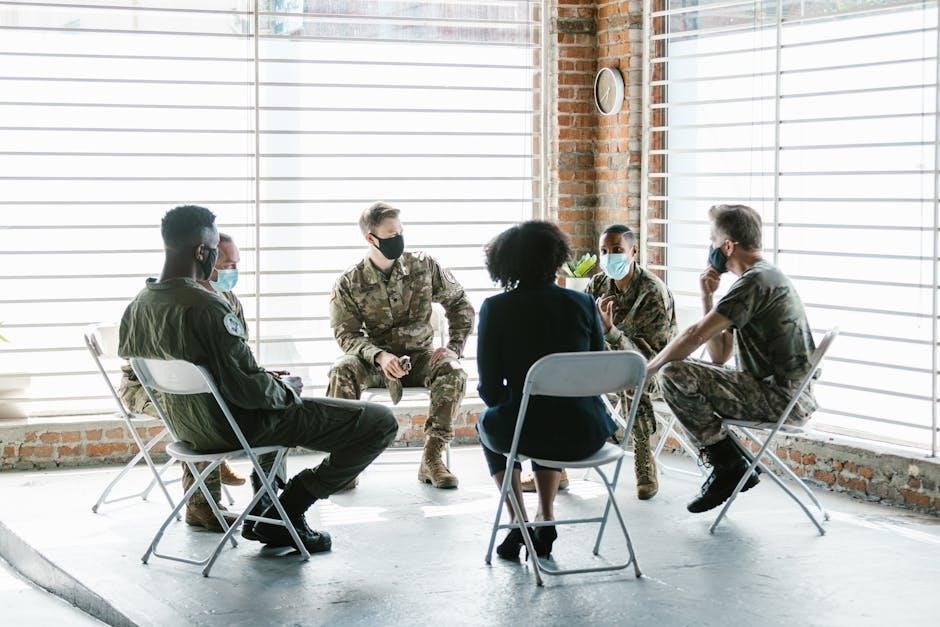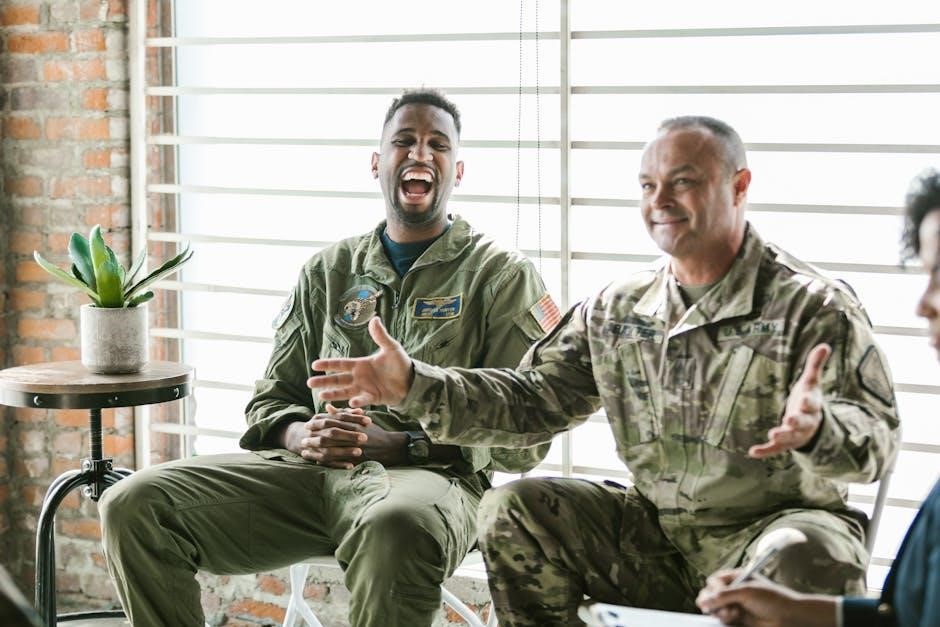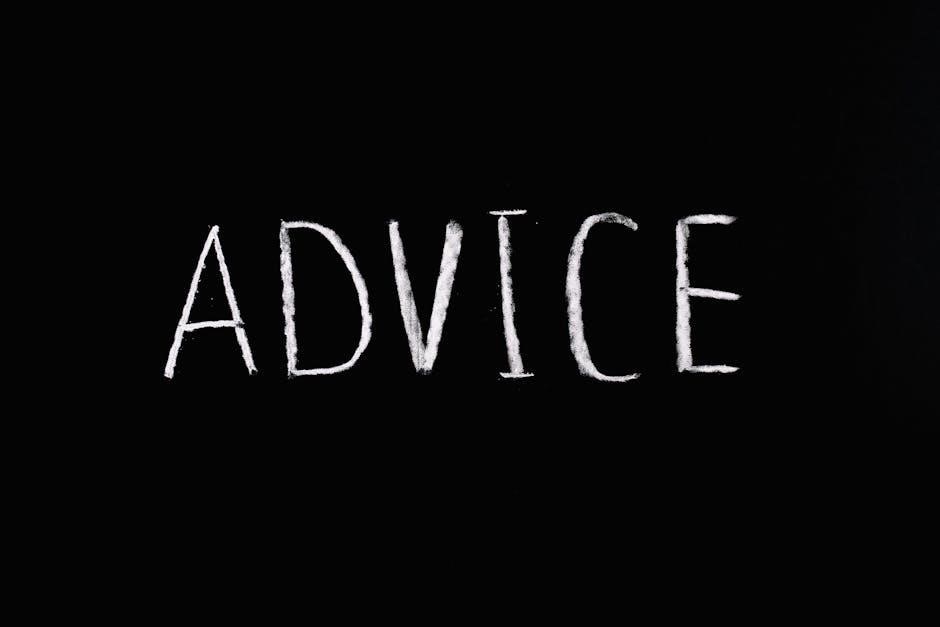
navy counseling chit instruction
A Navy counseling chit is a formal document used to document performance‚ behavior‚ and developmental feedback for sailors‚ ensuring accountability and growth within the naval framework.
1.1. What is a Counseling Chit?
A counseling chit is a formal document used by the U.S; Navy to provide structured feedback on a sailor’s performance‚ behavior‚ and professional development. It serves as a tool for documenting both positive achievements and areas needing improvement. The chit is typically completed on a standardized form‚ such as the NAVPERS 1616/25‚ and includes details like the date‚ sailor’s name‚ and specific feedback. It is a critical component of the Navy’s personnel management system‚ ensuring accountability and fostering growth. Counseling chits are often used for corrective actions or to recognize exceptional performance‚ making them essential for maintaining high standards within the naval service. They also provide a clear record for future reference and career development.
1.2. Purpose of Counseling Chits
The primary purpose of counseling chits is to provide structured feedback to sailors‚ addressing both positive performance and areas needing improvement. They serve as a documentation tool for maintaining accountability and fostering professional growth. Counseling chits are essential for recognizing exceptional achievements and correcting undesirable behavior‚ ensuring high standards within the naval service. They also create a formal record for career development and personnel management. While counseling can take various forms‚ the chit ensures that all interactions are documented‚ providing a clear reference for future evaluations and decisions. This documentation supports the Navy’s commitment to improving individual and unit performance effectively.

History of Navy Counseling Chits
Navy counseling chits have evolved over time‚ initially used for documenting performance and behavioral feedback. They were eventually replaced by page 13s to standardize documentation processes.
2.1. Background and Evolution
Navy counseling chits originated as tools for documenting sailor performance and behavioral feedback. Initially‚ they served as informal records for tracking progress and addressing issues. Over time‚ the process formalized‚ with structured forms like the NAVPERS 1616/25 being introduced to standardize documentation. These chits were crucial for sailor development‚ ensuring accountability and clarity in communication. However‚ as the Navy modernized‚ counseling chits were gradually phased out in favor of more streamlined methods‚ such as page 13 entries‚ to align with updated regulatory requirements and improve efficiency. Despite their discontinuation‚ the principles of counseling chits remain integral to the Navy’s approach to sailor evaluation and growth.
2.2. Relevance in Modern Navy Operations
While counseling chits have largely been replaced by page 13 entries and other documentation methods‚ their principles remain relevant in modern Navy operations. The emphasis on formalized feedback and accountability ensures sailors receive clear guidance for improvement. Modern tools‚ such as digital platforms‚ have streamlined the counseling process‚ enhancing efficiency and accessibility. These updates align with the Navy’s commitment to maintaining high standards of performance and professionalism. The transition to page 13 entries reflects the Navy’s adaptability to evolving regulatory requirements‚ ensuring that counseling practices remain effective and aligned with contemporary operational needs. This shift underscores the enduring importance of structured feedback in sailor development and career progression.

Importance of Counseling Chits
Counseling chits play a crucial role in documenting formal feedback‚ guiding sailor development‚ and ensuring accountability. They aid in addressing performance issues and fostering professional growth within the Navy framework.
3.1. Role in Sailor Development
Counseling chits are essential for documenting performance evaluations and providing constructive feedback to sailors. They help identify areas for improvement and create actionable development plans. By formally outlining expectations and goals‚ counseling chits guide sailors toward professional growth and readiness for advanced responsibilities. Regular feedback fosters accountability and ensures sailors understand their strengths and weaknesses. This structured approach supports mentorship and helps sailors align their career goals with naval objectives. Proper documentation also aids in tracking progress over time‚ enabling tailored interventions to address specific needs. Ultimately‚ counseling chits serve as a cornerstone for fostering a culture of continuous improvement and excellence within the Navy.
3;2. Impact on Career Advancement
Navy counseling chits significantly influence a sailor’s career advancement by documenting performance feedback and developmental goals. These records provide clear insights into a sailor’s strengths‚ areas for improvement‚ and progress over time. Positive counseling notes can enhance promotion potential‚ while constructive feedback helps address shortcomings. Commanding officers rely on these documents to assess readiness for advanced roles and specialized training. A well-documented counseling chit demonstrates accountability and commitment to growth‚ which are critical for career progression. By fostering transparency and accountability‚ counseling chits play a pivotal role in shaping a sailor’s professional trajectory and ensuring they meet the standards required for leadership and advancement in the Navy.

The Counseling Process
The counseling process involves initiating discussions between sailors and superiors‚ documenting goals‚ expectations‚ and follow-ups. It ensures accountability and supports Sailor development through structured feedback and guidance.
4.1. Steps to Fill Out the Form
Filling out a Navy counseling chit involves several structured steps. Begin by entering the service member’s name‚ date‚ and rating at the top of the form. Next‚ specify the counseling type‚ such as performance or misconduct-related. Clearly outline the purpose of the counseling‚ detailing specific behaviors or issues. Include actionable recommendations and goals for improvement. Ensure the member acknowledges the counseling by signing and dating the form. Finally‚ obtain the supervisor’s or commander’s signature for approval. Properly document follow-up actions and store the form securely. Adherence to these steps ensures clarity‚ accountability‚ and effective documentation of the counseling process.
4.2. Required Signatures and Approvals
The counseling chit requires specific signatures to validate the process. The service member must sign and date the form‚ acknowledging receipt of the counseling. The immediate supervisor or counselor must also sign‚ confirming the discussion and agreed-upon actions. In some cases‚ the commanding officer’s signature may be required for formal approval. Proper authentication ensures accountability and verifies the counseling’s legitimacy. Maintaining a copy in the service member’s record is essential for future reference. These signatures and approvals streamline the documentation process‚ ensuring clarity and compliance with naval regulations. They also provide a clear audit trail for tracking progress and accountability.

Forms and Documentation
NAVPERS 1616/25 and Page 13 are primary forms used for documenting counseling actions. They ensure standardized reporting of performance‚ behavior‚ and developmental feedback‚ aligning with naval procedures.
5.1. NAVPERS 1616/25 Form Details
The NAVPERS 1616/25 form‚ or Record of Enlisted Counseling‚ is a standardized document used by the U.S. Navy to document counseling sessions. It provides a structured format for detailing performance evaluations‚ behavioral feedback‚ and developmental goals. The form includes sections for the member’s name‚ date‚ pay grade‚ and social security number. It also requires specific details about the counseling session‚ such as the reason for counseling and follow-up actions. Signatures from both the counselor and the member are mandatory‚ ensuring accountability and mutual understanding. This form plays a critical role in maintaining formal records of counseling actions‚ supporting career development and accountability within the naval framework.
5.2. Page 13 vs. Counseling Chits
Page 13 and counseling chits serve distinct purposes in naval documentation. Page 13 is a formal document within a service member’s official record‚ used for significant performance issues or administrative actions. Counseling chits‚ on the other hand‚ were historically used for informal‚ routine counseling sessions. However‚ counseling chits have been phased out‚ with Page 13 now serving as the primary tool for documenting both formal and informal counseling. This shift streamlines documentation processes and ensures consistency; While counseling chits were once preferred for their simplicity‚ Page 13 now provides a more comprehensive and permanent record‚ aligning with the Navy’s emphasis on accountability and transparency in performance management.

Digital Tools and Resources
The Navy offers online platforms and electronic forms like NAVPERS 1616/25 for streamlined counseling documentation‚ enhancing efficiency and accessibility in modern naval operations and record-keeping processes.
6.1. Online Platforms for Counseling
Online platforms simplify counseling processes by providing e-forms like NAVPERS 1616/25‚ enabling digital submissions and secure storage. These tools enhance accessibility‚ allowing sailors to access records anytime‚ anywhere. Digital platforms also offer real-time collaboration between counselors and sailors‚ improving communication and efficiency. Many systems integrate with existing naval databases‚ ensuring seamless updates and compliance with regulations. Additionally‚ online platforms often include templates and guidance to help counselors draft accurate and effective feedback. These resources promote consistency and reduce administrative burdens‚ making the counseling process more streamlined and effective. They also support the Navy’s commitment to modernizing its operations and improving sailor development. Security features ensure confidentiality and proper documentation.

Legal and Regulatory Aspects
Navy counseling chits are governed by Departmental Regulations and 5 U.S. Code 301‚ ensuring compliance and proper documentation of counseling actions for accountability and transparency purposes.
7.1. Authority and Compliance
The authority for Navy counseling chits is derived from Departmental Regulations and 5 U.S. Code 301‚ which mandates the documentation of counseling actions. Compliance with these regulations ensures that all counseling sessions are formally recorded‚ maintaining accountability and transparency. The primary purpose of this documentation is to provide a clear record of performance feedback‚ behavioral corrections‚ or developmental guidance provided to sailors. Proper compliance also ensures that counseling actions align with established naval policies and procedures. Failure to adhere to these guidelines may result in disciplinary actions or invalidation of the counseling process. Thus‚ strict adherence to authority and compliance is essential for the effectiveness of Navy counseling chits.
7.2. Privacy Considerations
Privacy is a critical aspect of Navy counseling chits‚ as they contain sensitive personal information about sailors. Access to these documents is restricted to authorized personnel to prevent unauthorized disclosure. Counseling records are protected under federal regulations and must be stored securely to maintain confidentiality. Improper handling or disclosure of these records can lead to legal consequences. Sailors have the right to review their counseling documents‚ but this must be done through official channels. Ensuring privacy safeguards the dignity of individuals and upholds trust in the counseling process. Proper handling of these records is essential to maintaining professionalism and accountability within the naval community.

Case Studies
Real-life examples highlight the effectiveness of Navy counseling chits in improving sailor performance and addressing behavioral issues. Successful outcomes demonstrate how structured feedback leads to positive change‚ enhancing career growth and unit cohesion.
8.1. Successful Counseling Outcomes
Successful counseling outcomes often result in improved performance‚ corrected behavior‚ and enhanced career advancement opportunities for sailors. Documentation through NAVPERS 1616/25 ensures accountability and clarity in developmental goals. Positive outcomes are achieved when sailors actively engage with feedback‚ demonstrating measurable progress. Counseling chits historically played a key role in this process‚ though modern practices emphasize digital tools and page 13 documentation. Real-life examples show how structured feedback fosters personal and professional growth‚ aligning individual goals with naval expectations. Effective communication and follow-up ensure long-term success‚ reinforcing the importance of counseling in maintaining a disciplined and effective naval workforce. These outcomes highlight the enduring value of counseling in sailor development.

Best Practices
Effective communication and professionalism are essential during counseling sessions. Ensure documentation is accurate and timely‚ using standard forms like NAVPERS 1616/25 and page 13.
Thorough preparation‚ active listening‚ and constructive feedback are critical. Maintain confidentiality and follow up on agreed actions to ensure accountability and successful outcomes for sailors.
9.1. Effective Communication Techniques
Effective communication is the cornerstone of successful counseling sessions. Active listening‚ clarity‚ and empathy are essential to ensure understanding and build trust. Use clear‚ objective language to provide constructive feedback‚ focusing on specific behaviors rather than personal traits. Encourage open dialogue by creating a supportive environment where sailors feel comfortable discussing challenges. Document discussions accurately using approved forms like NAVPERS 1616/25 or page 13‚ ensuring consistency and accountability. Follow up on agreed actions to monitor progress and provide additional guidance when needed. Professionalism and respect should always guide interactions to foster personal and professional growth within the naval framework.
9.2. Proper Documentation Practices
Proper documentation is critical for maintaining accurate records and ensuring accountability in counseling processes. Use approved forms such as NAVPERS 1616/25 or page 13 for consistency. Ensure all entries are dated‚ signed‚ and include specific details about the counseling session‚ such as the sailor’s name‚ rank‚ and the issues discussed. Keep records organized and confidential‚ adhering to privacy regulations. Avoid informal notes or verbal agreements‚ as they may not hold legal weight. Regularly review and update documentation to reflect progress or changes. Accurate and timely documentation ensures transparency‚ supports career development‚ and provides a clear reference for future evaluations or legal requirements. Maintain professionalism and attention to detail throughout the process.
Navy counseling chits remain vital for documenting performance and development‚ ensuring accountability and compliance with regulations. Their structured format aids in clear communication and growth tracking.
Though counseling chits have evolved‚ their essence remains unchanged‚ emphasizing transparency and professionalism in sailor development. Adapting to modern tools like page 13 ensures continued effectiveness and compliance.
10.1; Summary of Key Points
Navy counseling chits are essential tools for documenting performance‚ behavior‚ and developmental feedback‚ ensuring accountability and compliance with naval regulations. They provide a structured format for clear communication between sailors and their superiors‚ aiding in personal and professional growth. The use of forms like NAVPERS 1616/25 emphasizes the importance of proper documentation and transparency. Counseling chits serve as a formal record of feedback‚ helping sailors understand areas for improvement and track their progress. While traditional chits have evolved‚ their purpose remains unchanged‚ focusing on fostering accountability and professionalism. This structured approach ensures that sailors receive consistent guidance‚ supporting their career advancement and overall development within the Navy.
10.2. Future of Counseling Chits
The future of Navy counseling chits lies in digitization and integration with modern tools to enhance efficiency and accessibility. Digital platforms are expected to streamline the counseling process‚ reducing paperwork and improving record-keeping. Automation will likely play a key role‚ enabling real-time tracking of sailor progress and facilitating better communication between sailors and their superiors. Additionally‚ the Navy may adopt more standardized templates and online systems to ensure consistency and compliance across all commands. This shift aligns with the Navy’s broader goals of modernization and operational efficiency. While the core purpose of counseling chits will remain unchanged‚ their delivery and management will evolve to meet the demands of a rapidly changing military environment.

Frequently Asked Questions
- What is a counseling chit? It is a formal document used to provide feedback on performance and behavior.
- How are counseling chits used? They document developmental feedback and accountability for sailors.
- What is the difference between counseling chits and page 13? Counseling chits are specific to performance‚ while page 13 is for broader evaluations.
11.1. General Inquiries
General inquiries about Navy counseling chits often revolve around their purpose‚ format‚ and usage. Sailors and supervisors frequently ask about the difference between counseling chits and other forms like page 13. Many wonder if counseling chits are still in use‚ as some sources suggest they have been replaced by Performance Evaluation reports. Others inquire about the proper way to fill out the NAVPERS 1616/25 form and the required signatures. Additionally‚ questions arise about the confidentiality of counseling records and how they impact career advancement. Understanding these basics is essential for effective use of counseling tools within the Navy’s administrative framework.
11.2. Submission and Storage Procedures
The submission and storage of Navy counseling chits follow specific protocols to ensure confidentiality and proper documentation. Once completed‚ the form must be signed by the sailor and their supervisor‚ then submitted to the appropriate personnel office. Counseling records are typically stored in the sailor’s official military personnel file‚ with digital copies maintained in secure systems. Proper storage ensures compliance with privacy regulations and protects sensitive information. Commands are responsible for maintaining accurate records and ensuring timely submission to prevent delays in career decisions. Digital platforms now offer secure alternatives for storing and managing counseling documentation‚ enhancing accessibility while maintaining confidentiality.